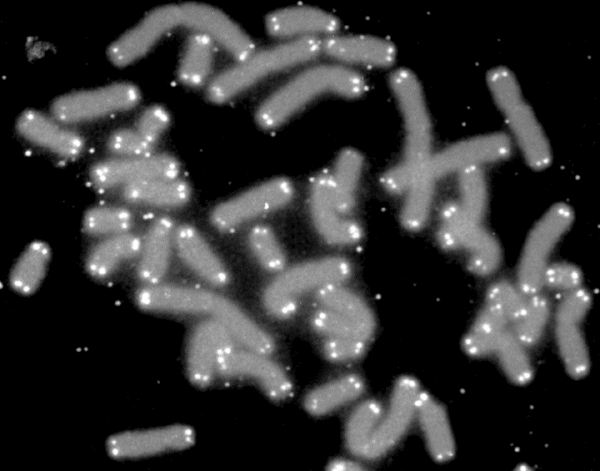
Telomere
A telomere (/ˈtɛləmɪər, ˈtiːlə-/; from Ancient Greek τέλος (télos) 'end', and μέρος (méros) 'part') is a region of repetitive nucleotide sequences associated with specialized proteins at the ends of linear chromosomes (see Sequences). Telomeres are a widespread genetic feature most commonly found in eukaryotes. In most, if not all species possessing them, they protect the terminal regions of chromosomal DNA from progressive degradation and ensure the integrity of linear chromosomes by preventing DNA repair systems from mistaking the very ends of the DNA strand for a double-strand break.
For the use of "telomere" in insect morphology, see Telomere (insect morphology). For other uses, see Telomere (disambiguation).Discovery[edit]
The existence of a special structure at the ends of chromosomes was independently proposed in 1938 by Hermann Joseph Muller, studying the fruit fly Drosophila melanogaster, and in 1939 by Barbara McClintock, working with maize.[1] Muller observed that the ends of irradiated fruit fly chromosomes did not present alterations such as deletions or inversions. He hypothesized the presence of a protective cap, which he coined "telomeres", from the Greek telos (end) and meros (part).[2]
In the early 1970s, Soviet theorist Alexey Olovnikov first recognized that chromosomes could not completely replicate their ends; this is known as the "end replication problem". Building on this, and accommodating Leonard Hayflick's idea of limited somatic cell division, Olovnikov suggested that DNA sequences are lost every time a cell replicates until the loss reaches a critical level, at which point cell division ends.[3][4][5] According to his theory of marginotomy, DNA sequences at the ends of telomeres are represented by tandem repeats, which create a buffer that determines the number of divisions that a certain cell clone can undergo. Furthermore, it was predicted that a specialized DNA polymerase (originally called a tandem-DNA-polymerase) could extend telomeres in immortal tissues such as germ line, cancer cells and stem cells. It also followed from this hypothesis that organisms with circular genome, such as bacteria, do not have the end replication problem and therefore do not age.
In 1975–1977, Elizabeth Blackburn, working as a postdoctoral fellow at Yale University with Joseph G. Gall, discovered the unusual nature of telomeres, with their simple repeated DNA sequences composing chromosome ends.[6] Blackburn, Carol Greider, and Jack Szostak were awarded the 2009 Nobel Prize in Physiology or Medicine for the discovery of how chromosomes are protected by telomeres and the enzyme telomerase.[7]
Shortening[edit]
Oxidative damage[edit]
Apart from the end replication problem, in vitro studies have shown that telomeres accumulate damage due to oxidative stress and that oxidative stress-mediated DNA damage has a major influence on telomere shortening in vivo. There is a multitude of ways in which oxidative stress, mediated by reactive oxygen species (ROS), can lead to DNA damage; however, it is yet unclear whether the elevated rate in telomeres is brought about by their inherent susceptibility or a diminished activity of DNA repair systems in these regions.[26] Despite widespread agreement of the findings, widespread flaws regarding measurement and sampling have been pointed out; for example, a suspected species and tissue dependency of oxidative damage to telomeres is said to be insufficiently accounted for.[27] Population-based studies have indicated an interaction between anti-oxidant intake and telomere length. In the Long Island Breast Cancer Study Project (LIBCSP), authors found a moderate increase in breast cancer risk among women with the shortest telomeres and lower dietary intake of beta carotene, vitamin C or E.[28] These results [29] suggest that cancer risk due to telomere shortening may interact with other mechanisms of DNA damage, specifically oxidative stress.
Measurement[edit]
Several techniques are currently employed to assess average telomere length in eukaryotic cells. One method is the Terminal Restriction Fragment (TRF) southern blot.[47][48] There is a Web-based Analyser of the Length of Telomeres (WALTER), software processing the TRF pictures.[49] A Real-Time PCR assay for telomere length involves determining the Telomere-to-Single Copy Gene (T/S) ratio, which is demonstrated to be proportional to the average telomere length in a cell.[50]
Tools have also been developed to estimate the length of telomere from whole genome sequencing (WGS) experiments. Amongst these are TelSeq,[51] Telomerecat[52] and telomereHunter.[53] Length estimation from WGS typically works by differentiating telomere sequencing reads and then inferring the length of telomere that produced that number of reads. These methods have been shown to correlate with preexisting methods of estimation such as PCR and TRF. Flow-FISH is used to quantify the length of telomeres in human white blood cells. A semi-automated method for measuring the average length of telomeres with Flow FISH was published in Nature Protocols in 2006.[54]
While multiple companies offer telomere length measurement services, the utility of these measurements for widespread clinical or personal use has been questioned.[55][56] Nobel Prize winner Elizabeth Blackburn, who was co-founder of one company, promoted the clinical utility of telomere length measures.[57]
In wildlife[edit]
During the last two decades, eco-evolutionary studies have investigated the relevance of life-history traits and environmental conditions on telomeres of wildlife. Most of these studies have been conducted in endotherms, i.e. birds and mammals. They have provided evidence for the inheritance of telomere length; however, heritability estimates vary greatly within and among species.[58] Age and telomere length often negatively correlate in vertebrates, but this decline is variable among taxa and linked to the method used for estimating telomere length.[59] In contrast, the available information shows no sex differences in telomere length across vertebrates.[60] Phylogeny and life history traits such as body size or the pace of life can also affect telomere dynamics. For example, it has been described across species of birds and mammals.[61] In 2019, a meta-analysis confirmed that the exposure to stressors (e.g. pathogen infection, competition, reproductive effort and high activity level) was associated with shorter telomeres across different animal taxa.[62]
Studies on ectotherms, and other non-mammalian organisms, show that there is no single universal model of telomere erosion; rather, there is wide variation in relevant dynamics across Metazoa, and even within smaller taxonomic groups these patterns appear diverse.[63]